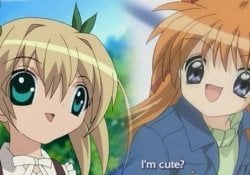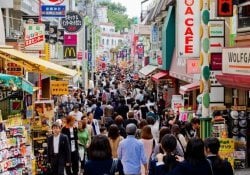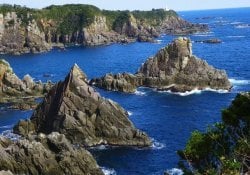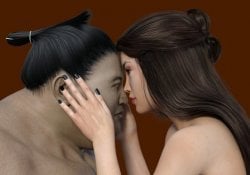In this article, we are going to have a list of demons, ghosts, yōkai, obake, yūrei and other legendary creatures that are notable in Japanese folklore and mythology. A complete list with a brief description of each creature from the legends of Japan.
We already had some articles about these mythical creatures from Japan like:
I hope you enjoy this list of over 306 monsters, creatures and ghosts from Japanese mythology. This article may be useful for those who wish to have a brief description or to know the name of a certain creature.
Note that this article has not been fully revised. It would take time to review the description of the 306 monsters that were translated from English. In my quick review I managed to get out a lot of incomprehensible stuff.
Feel free to comment on something that is impossible to understand so I can make manual changes. Thank you for reading our article, we appreciate the comments and shares. We recommend using CTRL + F to search the page.
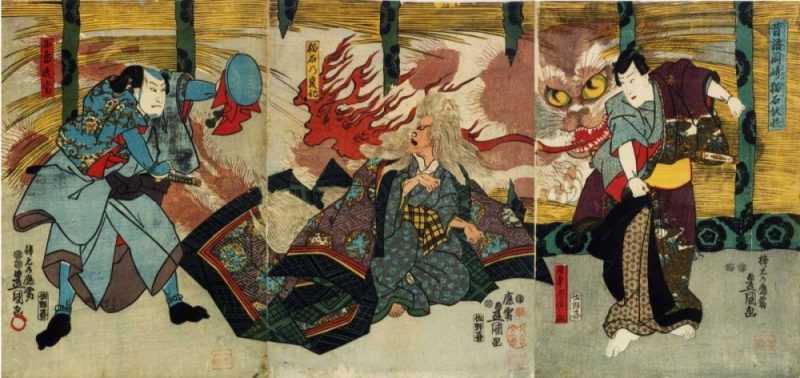
Yokais, Obake, Yurei, Japanese Ghosts and Demons
Remembering that if you are on mobile devices, just drag your finger to the side in order to handle the table view.
Responsive Table: Scroll the table sideways with your finger >>
| Abumi-guchi | A furry creature formed from the stirrup of a mounted military commander who worked for Yamata no Orochi. |
| Abura-akago | A childish ghost who licks oil from andon lamps. |
| Abura-sumashi | A spirit with a big head that lives in a mountain pass in Kumamoto Prefecture. |
| Akabeko | A red cow involved in the construction of Enzō-ji in Yanaizu, Fukushima. |
| Akaname | A spirit that licks up the dirt in messy bathrooms. |
| akashite | A creature that appears in a black cloud over a floodgate. |
| Akateko | A red hand hanging from a tree. |
| Akkorokamui | An Ainu monster resembling a fish or octopus. |
| Akubōzu | Akubōzu, living in the ashes of fireplaces, are from Akita and Iwate. |
| Akurojin-no-hi | A ghostly fire from Mie Prefecture. |
| Amabie | A Japanese mermaid yokai. |
| Amaburakosagi | A ritual-disciplinary demon of Shikoku. |
| Amamehagi | A ritual-disciplinary demon of Hokuriku. |
| Amanojaku | A little demon who incites people to evil. |
| Amanozako | A monstrous goddess mentioned in the Kujiki. |
| Amaterasu | A sun goddess. |
| Amazake-babaa | An old woman who asks for sweet love and brings disease. |
| Amefurikozō | A boy spirit that plays in the rain. |
| Amemasu | An Ainu creature resembling a fish or whale. |
| Ameonna | A female spirit that makes it rain. |
| Amikiri | A bird spirit, with a bird's head, a crustacean trap, and a snake's body. |
| Amorōnagu | A Tennyo from the island of Amami Shima. |
| Massage | A ritual-disciplinary demon from Iwate Prefecture. |
| Aoandon | The demonic spirit that emerges from an andon lamp at the end of a Hyakumonogatari Kaidankai. |
| Aobōzu | The blue monk who kidnaps children. |
| Aonyōbō | A ghost that lurks in an abandoned imperial palace. |
| Aosaginohi | A luminescent heron. |
| Arikura-no-baba | An old woman with magical powers. |
| Ashimagari | A spirit that envelops the legs of travelers. |
| Ashinagatenaga | A pair of characters, one with long legs and one with long arms. |
| Ayakashi (yōkai) | A phenomenon considered the funayurei. |
| Azukiarai (or Azukitogi) | A spirit that washes adzuki beans. |
| Bake-kujira | A ghostly whale skeleton that floats along the coast of Shimane Prefecture. |
| Bakeneko | A shape-shifting cat. |
| Bakezōri | A zōri sandal spirit. |
| Baku (espírito) | Supernatural beings that devour dreams and nightmares. |
| Basan | A large fire-breathing chicken monster. |
| Bashōnosei | banana tree spirit |
| Bebeto-san | Invisible spirit that follows people at night, producing the sound of footsteps. |
| Binbogami | The spirit of poverty. |
| Biwa-bokuboku | Animated biwa lute. |
| Buruburu | A spirit that clings to people who induce cowardice and shivers. |
| Byakko | Japanese version of the Chinese white tiger. |
| Byōbunozoki | Tsukumogami who emerges from byōbu to spy on people. |
| Chōchinbi | Demonic flames that appear on the paths between the rice fields. |
| Chōchinobake | A possessed chochin lantern. |
| Daidarabotchi | A giant responsible for creating the geographical features of Japan. |
| Daitengu | The most powerful tengu, each of which lives on a separate mountain. |
| Danzaburou-danuki | a bake-danuki from Sado Island. |
| Datsue-ba | An old woman in the underworld who removes clothing (or skin, if unclothed) from the dead. |
| Dodomeki | A hundred-eyed demon. |
| Dōnotsura | A headless human yōkai with its face on its torso. |
| Enenra | A monster made of smoke. |
| Enkō | Kappa from Shikoku and Western Honshū. |
| Funayūrei | Ghosts of people who died at sea. |
| Furaribi | A creature engulfed in flames that flies around aimlessly. |
| Furu-utsubo | A beloved quiver of dead archers. |
| Furutsubaki-no-rei | A soul-sucking plant. |
| Futakuchi-onna | The two-mouthed woman. |
| Fūjin | The god of wind. |
| Fūri | A yokai monkey. |
| stutter | A demon that attacked young priests at the Gangō-ji temple. |
| Gaki | Hungry ghosts of especially greedy people. |
| Gashadokuro | A giant skeleton that is the spirit of the unburied dead. Also known as Gaikotsu. |
| Genbu | Japanese version of the Chinese black turtle. |
| Goryō | The vengeful spirits of the dead. |
| Gozu and Mezu | Underworld guards. |
| Guhin | Another name for tengu. |
| Gyūki | Another name for Ushi-oni. |
| Hachishaku-sama | An 8 foot tall woman and famous for kidnapping children. |
| Hakanohi | A fire that kindles in graves. |
| Hakuja no Myojin | A white serpent God. |
| Hakutaku | A beast that imparted knowledge about harmful spirits. |
| Hanako-san | The spirit of a young WWII girl who inhabits and haunts school toilets. |
| Hannya | A noh mask representing a jealous demon. |
| Haradashi | A creature with a giant face in its stomach. |
| Harionago | A woman with a prickly barb at the end of each lock of her hair. |
| Hashihime | A woman-turned-spirit associated with the bridge at Uji. |
| Heikegani | Crabs with shells with human face. They are the spirits of the warriors killed in the Battle of Dan-no-ura. |
| Hibagon | The Japanese version of Bigfoot or Yeti. |
| Hiderigami | The spirit of drought. |
| Hihi | A baboon-like Chinese yokai. |
| Hikeshibaba | An old woman who puts out lanterns. |
| Hymn | The sunrise. |
| Hitodama | A fireball ghost that appears when someone dies, signifying the dead person's spirit. |
| Hitotsume-kozō | A one-eyed childlike spirit. |
| Hitotsume-nyūdō | A one-eyed monk spirit. |
| Hiyoribō | The spirit that stops the rains. |
| Hoji | The wicked spirit of Tamamo-no-Mae. |
| Hone-onna | The Skeleton Woman. |
| Hoshi-no-Tama | A ball guarded by a Kitsune (fox) that can give whoever gains power to force Kitsune to help them. It is said to have some reserves of Kitsune power. |
| Hotoke | A deceased person. |
| Hyakki Yakō | The night parade of demons. |
| Hyōsube | A kind of hair-covered Kappa. |
| Hō-ō | China's legendary Fenghuang bird. |
| Hōsōshi | A ritual exorcist. |
| Ibaraki-doji | Daughter of an oni. |
| Ichiren-Bozu | Animated prayer beads. |
| Ikiryō | Essentially a living ghost, as it is the soul of a person living outside their body. |
| Ikuchi | A sea serpent that travels over boats in an arc while dripping oil. |
| Inugami Gyoubu | A type of bake-danuki. |
| Inugami | A dog spirit created, worshiped, and employed by a family through sorcery. |
| Isonade | A fish-like sea monster with a tail covered in barbs. |
| Issie | A lake monster. |
| Itsumade | A fire-breathing bird monster. |
| Ittan-momen | A possessed cotton roll that tries to suffocate people by wrapping itself around their faces. |
| Iyaya | A woman whose face is reflected as an old man. |
| Jami | A wicked mountain spirit. |
| Janjanbi | A soul in the form of a fireball, named for the sound it makes. |
| Jatai | Animated folding screen cloth. |
| Jibakurei | A spirit that protects a specific place. |
| Jikininki | Ghosts that eat human corpses. |
| Jinmenju | A tree with fruits with a human face. |
| Jishin-namazu | The giant catfish that causes earthquakes and tsunami. He was blamed during the Ansei earthquake and tsunami. |
| Jorōgumo | A spider woman. |
| Jubokko | A vampire tree. |
| Kahaku河伯) | Another name for a Kappa. |
| Kakurezato | |
| Kamaitachi | The sickle-clawed weasel that haunts the mountains. |
| Kambarinyūdō | A monk spirit that spies on people who use the toilet. |
| Kameosa | A bottle of possessed sake. |
| Kanedama | A spirit that carries money. |
| Kappa | A famous aquatic monster with a head full of water and a love for cucumbers. |
| Karasu-tengu | Crow Demon. |
| Karura | Anthropomorphic eagle similar to the Hindu Garuda. |
| Kasa-obake | A possessed paper umbrella monster. |
| Kasha | A cat-like demon that descends from the sky and takes away corpses. |
| Katawaguruma | A type of Wanyudo, with an anguished woman instead of a monk's head on a burning wheel. |
| Kawaakago | A river spirit that pretends to be a crying baby. |
| Kawauso | River otters. |
| Kechibi | Fireballs with human faces inside. |
| Keneō | An old man sitting in the underworld who weighs the clothes Datsue-ba gave him. |
| Keukegen | A small dog-like creature, covered entirely in long hair. |
| Kijimuna | A tree sprite from Okinawa. |
| Kirin | The Japanese version of China's Qilin, which is part dragon and part deer with antlers, fish scales and an ox tail. Said to be a protective creature and guardian of the metal element. |
| Kitsune no yomeiri | Ghost of Light |
| Kitsune | A fox spirit. |
| Kitsunebi | Flames created by Kitsune. |
| Kiyohime | A woman who turned into a serpent demon out of the rage of unrequited love. |
| Kodama | A spirit that lives in a tree. |
| Kokakuchō | The Ubume bird. |
| Komainu | The pair of lion dogs that guard the temple entrances. |
| Konaki-jiji | This yokai disguises himself as an abandoned baby and then cries until someone catches him. |
| Konoha-tengu | A bird-like Tengu. |
| Koromodako | An octopus-like Yokai that lives in the waters bordering Kyoto and Fukui. |
| Koropokkuru | A little person from Ainu folklore. |
| Kosenjōbi | Fireballs that float over ancient battlefields. |
| Kosode-no-te | A possessed kosode. |
| Kubikajiri | Feminine spirit of the cemetery that chews the corpse. |
| Kuchisake-onna | The woman with the slit mouth. |
| Kuda-gitsune | A small fox animal used in sorcery. |
| Kudan | A cow with a human face. |
| Kumo Yōkai | A Japanese spider demon. |
| Kyonshī | The Japanese version of the Chinese jumping vampire, known as "jiangshi". |
| Kyōkotsu | A skeletal figure emerging from a well. |
| Kyōrinrin | Rolls or papers owned. |
| Mekurabe | The multiplier skulls that threatened Taira no Kiyomori in her courtyard. |
| Miage-nyūdō | A spirit that grows as fast as you can look at it. |
| Mikaribaba | A one-eyed old woman. |
| Mikoshi-nyūdō | A bald goblin with an extended neck. |
| Misaki | High-ranking divine spirits. |
| Mizuchi | A dangerous water dragon. |
| Mokumokuren | A swarm of eyes appearing on a paper sliding door in an old building. |
| Momonjī | An old man who is waiting for travelers at every fork in the road. |
| Mononoke | Any mischievous and troublesome creature/entity of uncertain origin. |
| Morinji-no-kama | Another name for Bunbuku Chagama, the bake-danuki kettle. |
| Mujina | A shape-shifting badger. |
| Myōbu | A title sometimes given to a fox. |
| Mōryō | A general term for various corpse-eating water demons. |
| Namahage | A ritual-disciplinary demon from the Oga Peninsula. |
| Namazu | A giant catfish that causes earthquakes. |
| Nekomata | A yokai cat. |
| Ningyo | A fish person or "mermaid". |
| Nobusuma | A flying squirrel monster (possibly inspired by the giant Indian flying squirrel). |
| Noderabō | Strange creatures that stand near a temple bell. |
| Nogitsune | A dangerous kitsune. |
| Noppera-bō | A faceless ghost. |
| Nozuchi | A fat creature like a snake. |
| new | A monster with the head of a monkey, the body of a raccoon dog, the legs of a tiger, and a snake-headed tail. He plagued the emperor with nightmares in the Heike Monogatari. |
| Nukekubi | A cruel, human monster whose head detaches from its body, often mistaken for the Rokurokubi. |
| Nupeppo | An animated piece of decomposing human flesh. |
| Nurarihyon | A strange character who sneaks into houses on busy nights. |
| Nure-onna | A female snake monster that appears on the beach. |
| Nuribotoke | An animated corpse with blackened flesh and swaying eyes. |
| Nurikabe | A ghostly wall that traps a traveler at night. |
| Nyūdō-bōzu | A yokai that grows bigger the longer it looks up. |
| Nyūnaisuzume | Sparrows that flew from the mouth of the exiled poet Fujiwara-no Sanekata. |
| Obake (or Bakemono) | Shape-shifting spirits. |
| Oriyon | Yōkai, who rides over a human victim and becomes unbearably heavy. |
| Oboroguruma | An oxcart with a face on the carriage. |
| hiwa | The ghost of a woman with a distorted face who was murdered by her husband. One of the most famous onryō. |
| okku | The ghost of counting a maid's plate. |
| Okuri-inu | A spectral dog that follows lone travelers, attacking them if they trip. Similar to the black dog of English folklore. |
| Oni of Rashomon | |
| omni | The classic Japanese devil. It is an ogre-like creature that usually has horns. |
| omnibaba | The demonic witch of Adachigahara. |
| Onibi | A demonic flame that can suck life if people get too close. |
| Onihitokuchi | One-eyed Oni that kills and eats humans. |
| Onikuma | yōkai bear. |
| Onmoraki | A bird demon created from the spirits of freshly slain corpses. |
| Onmyoji | A human who has powers like those of a yōkai. |
| Onryō | A vengeful ghost formed by powerful feelings like anger or sadness. |
| Osakabe | An old yōkai residing in Himeji's castle who can read and manipulate hearts. |
| Otoroshi | A furry creature that lands at torii gates to shrines and temples. |
| Raijin | The God of Thunder. |
| Raijū | An animal that falls to earth in lightning. |
| Rokurokubi | A person, usually female, whose neck can stretch indefinitely. |
| Ryuu | The Japanese Dragon. |
| Rōjinbi | A ghostly fire that appears with an elderly person. |
| Sa Gojō | The water monster Sha Wujing from Journey to the West, often interpreted in Japan as a kappa. |
| Samebito | A shark from the Dragon Palace submarine. |
| Sankai | An amorphous postpartum spirit. |
| Sansei | A humanoid with a single leg twisted backwards. |
| Sarakazoe | A type of onibi that appears as a counting board. |
| Satori | An ape-like creature that can read your thoughts. |
| Sazae-oni | A turbaned snail that transforms into a woman. |
| Seiryū | Japanese version of the Chinese Azure Dragon. |
| Sesshō-seki | The poisonous "killing stones" that Tamamo-no-Mae has turned into. |
| Shachihoko | A tiger-headed fish whose image is often used in architecture. |
| Shibaemon-tanuki | A danuki roast from Awaji Island. |
| Shichinin misaki | A group of seven ghosts that sicken the living. |
| Shidaidaka | A humanoid yokai that appears above the roads. |
| Shikigami | A spirit summoned to bid for an Onmyōji. |
| Shikome | Wild women sent by Izanami to harm Izanagi. |
| Shinigami | The Japanese Reaper. |
| Shiranui | A mysterious flame seen over the seas in Kumamoto Prefecture. |
| Shirime | An apparition in the form of a man with an eye for an anus. |
| Shiryō | The souls of the dead, the opposite of ikiryo. |
| Shirōneri | Mosquito nets or dusty clothes. |
| Shisa | The Okinawan version of Shishi. |
| Shishi | The paired lion dogs guarding temple entrances. |
| Shuten-doji | omni |
| Shōjō | Redhead marine sprites who love alcohol. |
| Shōkera | A creature that peers through the skylight of an old house. |
| Son Goku | Monkey King Sun Wukong from Journey to the West. |
| Suiko | Another name for kappa. |
| Sunakake Baba | A witch who uses sand. |
| Sunekosuri | A dog-like yokai that rubs people's legs when it rains. |
| Suzaku | The Japanese version of the Chinese vermilion bird. |
| Suzuri-no-tamashii | Ink spirit. |
| Sōjōbō | The famous Daitengu of Mount Kurama. |
| Taka-onna | A female monster that can stretch its waist to peer inside buildings. |
| Tamamo-no-Mae | An evil nine-tailed fox who appeared as a courtesan. |
| Tanuki | A shape-shifting Japanese raccoon dog. |
| tell me | The ghost of a blind man with his eyes in his hands. |
| Teke Teke | The vengeful spirit of a school girl, with a mid-upper torso body, who goes around killing people by cutting them in half with a scythe, mimicking her own disfigurement. |
| have | A mischievous shape-shifting weasel. |
| Tengu | A wise demon with two variants: a red man with a long nose or a bird-like demon. |
| Tenjōkudari | A female yokai that crawls on the ceiling. |
| Tenka (開花) | ghost lights |
| Tenko (raposa) | divine beast |
| Tennin | A heavenly being. |
| Teratsutsuki | The onryō of a man who lived in the 6th century CE. |
| Tesso | A priest who was snubbed by the emperor and turned into a swarm of rats that destroyed a rival temple. |
| Tsuchigumo | A clan of spider yokai. |
| Kappas? | A legendary serpentine monster. It is now a crypt that resembles a fat snake. |
| Tsukinowaguma | A legendary bear. |
| Tsukumogami | An animated tea carrier that Matsunaga Hisahide used to negotiate a peace with Oda Nobunaga. It is now understood as any 100-year-old inanimate object that has come to life. |
| Tsukuyomi | A moon god. |
| Tsurube-otoshi | A monster that falls from the treetops. |
| Tōfu-kozō | A yokai that appears as a boy carrying a plate of tofu. |
| Ubume | The spirit of a woman who died in childbirth. |
| Uma-no-ashi | The leg of a horse that hangs from a tree and kicks passersby. |
| Umi-nyōbō | A female sea monster that steals fish. |
| Umibōzu | A giant monster appearing on the surface of the sea. |
| Ungaikyō | A possessed mirror. |
| Ushi-no-tokimairi | A curse made at the time of the ox (between 1 and 3 am) by a black magic user, with various effects. |
| Ushi-oni | A name given to a variety of ox-headed monsters. |
| Ushi-onna | A woman dressed in a kimono with a cow's head. |
| Ushirogami | A one-eyed, footless spirit. |
| Uwan | A spirit called by the sound that screams when it surprises people. |
| Waira | A large animal that lurks in the mountains, about which little is known. |
| Wani | A water monster comparable to an alligator or crocodile. A related word was applied to the saltwater crocodile. |
| Wanyūdō | A flaming wheel with a man's head at the center, which sucks the soul out of anyone who sees it. |
| Yadōkai | Monks who have turned to mischief. |
| Yama-biko | Small creatures that create echoes. |
| Yama-inu | A mountain spirit resembling a dog, that may appear to travelers on mountain roads; it can be friendly or it can attack and kill the traveler, depending on the story (see also the Japanese wolf). |
| Yama-uba | An ancient yōkai. |
| Yamajijii | An old man with one eye and one leg. |
| Yamako | An occasionally cannibal friendly creature that can read minds. |
| Yamaoroshi | A possessed vegetable grater, almost porcupine looking. |
| Yamata no Orochi | The eight-headed dragon/serpent monster slain by the god Susanoo. |
| Yashima no Hage-tanuki | A bake-danuki that protects the Taira clan. |
| Yatagarasu | Amaterasu's three-legged crow. |
| Yato-no-kami | Deadly serpent gods that infested a field. |
| Yobuko | A spirit of living in the mountains. |
| Yomotsu-shikome | The witches of the underworld. |
| Yonakinoishi | |
| Yosuzume | A mysterious bird that sings at night, sometimes indicating that the okuri-inu is nearby. |
| Yuki-onna | The Snow Woman. |
| Yurei | Ghosts in a more western sense. |
| Yōkai / Youkai | A class of supernatural monsters, spirits, and demons in Japanese folklore. They can also be called ayakashi (妖?), mononoke (物の怪?) or mamono (魔物?). |
| Yōsei | The Japanese word for "fairy". |
| Zashiki-warashi | A protective childlike household spirit. |
| Zennyo Ryūō | A dragon that makes it rain. |
| Zorigami | An animated clock. |
| Zuijin | A tutelary spirit. |
| Zunbera-bō | Another name for Noppera-bō. |
| Ōgama | A giant frog that breathes rainbow-like smoke and wields a giant spear against anyone who attacks it. |
| Ōkaburo | transvestite yōkai |
| Ōkami | A powerful wolf spirit that takes your life or protects you depending on the actions someone takes in your life. |
| Ōkubi | The huge face of a woman that appears in the sky. |
| Ōmagatoki | Twilight. |
| Ōmukade | A giant human-eating centipede that lives in the mountains. |
| Ōnyūdō | Wastebasket taxon for all 'priestly' demons. |

